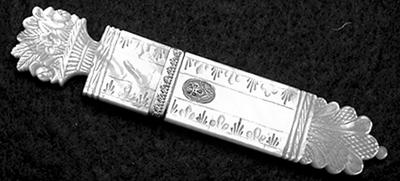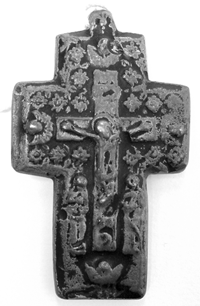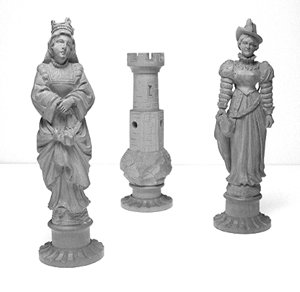I am Jennifer Louchheim, a senior majoring in Art History and student intern for the Art Collection. On my first day as intern, I was taken to a place I didn’t know existed: the Art Collection’s Vault. To my surprise, this small dark room with light bulbs hanging from the ceiling held hidden treasures from the most eclectic of sources.

One of my tasks as intern was to reconcile objects in The Vault with records compiled during recent decades. This turned out to be one of my favorite projects. I never knew what I was going to find in the boxes marked only as "Shelf 6: Box A," "Box B," etc. I found some of these objects quite intriguing, and likely to prove valuable sources of future study and possible Special Collections exhibitions. One of my favorite objects was the diminutive (3 5/16-inch long) perfume tube used by Empress Eugenie, wife of Napoleon III and decorated with minute and highly detailed carvings in ivory and with mother-of-pearl inlay. I found fascinating the fact that this beautiful personal piece from the lifetime of an empress of European royalty found its way to the Georgetown collection, ensconced securely inside The Vault.

Readers may find of particular interest, because of its relationship to the University’s Catholic heritage, a simple yet expressive crucifix in the Byzantine style, said to have been excavated in Jerusalem. Of course, older records sometimes contain what we may call apocryphal references, so further research by experts in the field can help determine with more precision the actual provenance of an object.

Adding to the Art Collection’s holdings of decorative arts are several exquisitely carved chess sets, including one in fine wood by Edward Lang, of the noted Lang family of carvers from Oberammergau, Germany. Donated in 1891 by landmark Georgetown benefactress Elizabeth Drexel (Mrs. John Vinton) Dahlgren, as a souvenir from her early attendance at a Passion Play, this set depicts the pieces in fanciful amalgamated court costumes from the time of the Thirty Years' War and other eras past; and was said in a Georgetown College Journal article in 1891 to be the only set ever carved by Edward Lang.

When we first saw the fourth item, we believed that it was a ceremonial cake server; but upon closer inspection we discerned that it actually was a ceremonial brick layer. But this was no ordinary brick layer: Inscribed on the spatula of the tool was "THE ANDREW WHITE MEMORIAL QUADRANGLE; JUNE 8 – 1930, COPLEY HALL; DECEMBER 8 – 1932,WHITEGRAVENOR BUILDING." This unusual artifact is yet another example of the many surprises—and illustrative connections to Georgetown’s history—awaiting patient discovery in The Vault. This internship has provided me the opportunity for an invaluable hands-on experience that I otherwise never would have had; I hope that my efforts prove valuable to future students and scholars who turn to Special Collections for their research into the cultural past.
